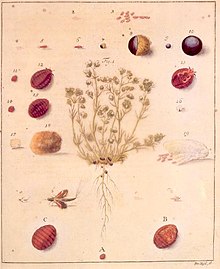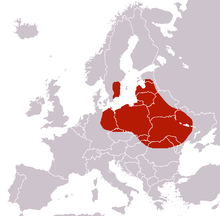| Polish cochineal | |
|---|---|

| |
| Life cycle of the Polish cochineal in Breyne's Historia naturalis Cocci Radicum... (1731) | |
| Scientific classification | |
| Domain: | Eukaryota |
| Kingdom: | Animalia |
| Phylum: | Arthropoda |
| Class: | Insecta |
| Order: | Hemiptera |
| Suborder: | Sternorrhyncha |
| Family: | Margarodidae |
| Genus: | Porphyrophora |
| Species: | P. polonica
|
| Binomial name | |
| Porphyrophora polonica | |

| |
| Area where the Polish cochineal was found in commercial quantities[1] | |
| Synonyms [2] | |
Polish cochineal (Porphyrophora polonica, Margarodes polonicus), also known as Polish carmine scales (Polish: czerwiec polski), is a scale insect formerly used to produce a crimson dye of the same name, colloquially known as "Saint John's blood". The larvae of P. polonica are sessile parasites living on the roots of various herbs – especially those of the perennial knawel (Polish: czerwiec trwały) – growing on the sandy soils of Central Europe and other parts of Eurasia. Before the development of aniline, alizarin, and other synthetic dyes, the insect was of great economic importance, although its use was in decline after the introduction of Mexican cochineal to Europe in the 16th century. Historically earlier was used Armenian cochineal scale insect, Porphyrophora hamelii, which is in a same taxonomic family Porphyrophora of the Polish cochineal and in different taxonomic family from cochineal found in the Americas.
- ^ Mushak, Paul (June–July 1988). "The Use of Insect Dyes in Oriental Rugs and Textiles: Some Unresolved Issues". Oriental Rug Review. VIII (5). Ron O'Callaghan. Archived from the original on 2013-07-01.
- ^ All synonyms from "uBio Project". The Marine Biological Laboratory. Retrieved 2007-01-26.